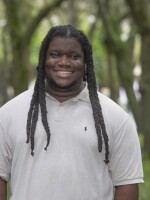A marker unveiled in St. Petersburg this week doesn’t just commemorate African-Americans lynched in the past, but also tries to educate people today about the city’s history.
The memorial, which is located near Dr. Martin Luther King Jr. Street and Second Ave. S. Is the work of two groups coming together.
Equal Justice Initiative (EJI), a non-profit organization that provides legal representation to the wrongfully convicted, teamed up with Pinellas Remembers, a group dedicated to uncovering the racial terror caused by lynchings in America.
The marker, which was revealed at a ceremony Tuesday, commemorates one particular victim: John Evans, a Black laborer from Dunnellon, who was killed by a mob of white residents at the intersection in 1914.
Leonora LaPeter Anton at the Tampa Bay Times wrote a comprehensive piece this week about Evans’ death and its repercussions (warning: some of the descriptions and photos in the report are graphic and disturbing).
Gwendolyn Reese, a co-chair of Pinellas Remembers, says there’s a significance about remembering our history -- good or bad.
“It informs the community of a part of history that has been totally omitted, and in any history, there is always a dark side for individuals or cities or countries, or history cannot be a beautiful picture at all times.”
Jacqueline Williams Hubbard, a former public defender and city attorney, spoke at the unveiling about how the community can take lessons from the past and apply them to turbulent times like the present day.
“Lynching victims have suffered untold horror and brutality for over 405 years since they were brought here on a Dutch slave ship in 1619,” she said.
“So the purpose for the memorial is not just to remember them. It is to spur us on to have a community-wide discussion on how we end the violence and how we come together in racial reconciliation.”
According to the Times, almost 6,500 lynchings took place in the United States between 1865 and 1950. Florida had the second-highest rate of lynchings, trailing only Mississippi.
In many states like Florida and Mississippi, there is little effort to discuss these events or even acknowledge them.
While the memorial markers are a step in the right direction, Reese said other steps can be taken.
“Part of it is education and not just education in the general community, but education in the school system, educating teachers so that they can adequately teach in a more comprehensive way,” she said.
Reese points to the African American Heritage Association of St. Petersburg, which has a memorial trail it encourages people to visit.
“At this time, we have 20 markers, and the lynching site has been included in our guided tours now,” said Reese. “That's another way to talk about these lynchings and any others that we identify in the future.”
EJI is also putting together several projects to keep the public informed on the history of the state of Florida and other areas where lynchings occurred. Additionally, they’ve assembled a detailed report on the history of lynching, along with a breakdown of laws against the crime.




